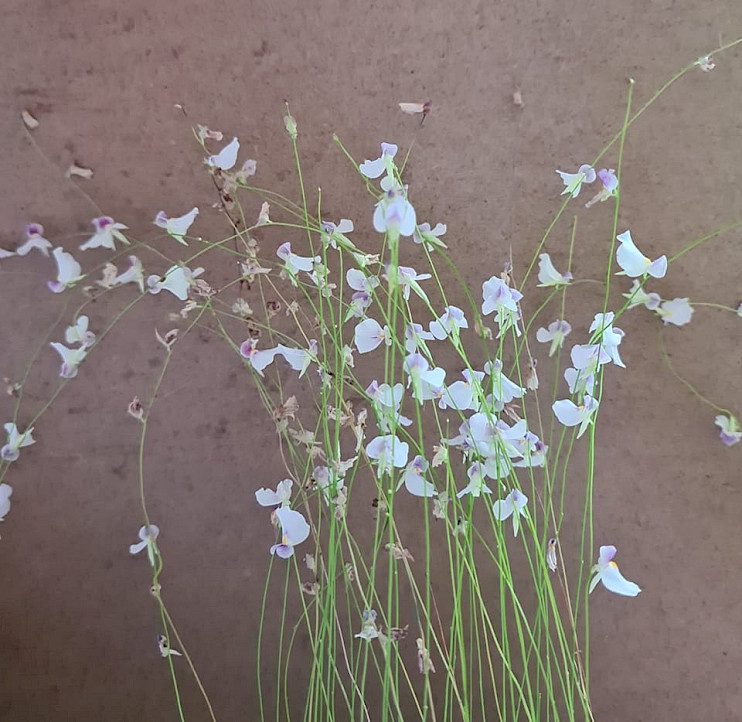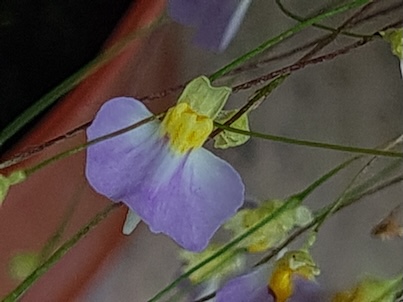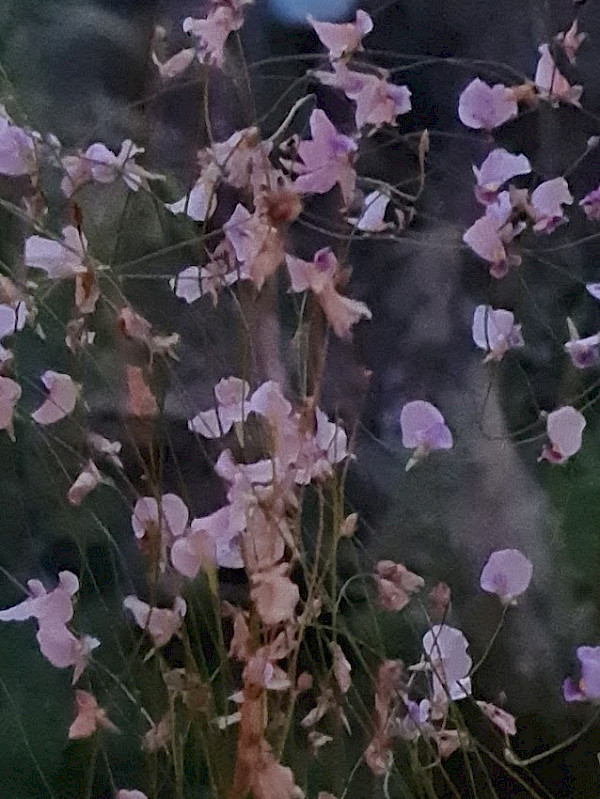


Utricularia blanchetii
General
Utricularia blanchetii is an enchanting small carnivorous plant, part of the bladderwort genus Utricularia. Native to Brazil, this species is known for its intricate traps and delicate, often violet-tinged flowers. Its tiny, almost moss-like stature makes it a favorite among terrarium and vivarium enthusiasts. Despite its unassuming appearance, it's both a tenacious survivor and a fascinating example of botanical ingenuity.
Physical Characteristics
This is a petite, mostly terrestrial species. Its slender leaves form rosettes or loose mats, barely a few centimeters across. The most striking feature is the tiny bladder traps (utricle), usually hidden underground or in wet moss, which are designed to catch microscopic prey. When in bloom, it produces delicate flower stalks up to 10 cm tall, with one to a few small, pastel-lavender flowers, each with beautifully ornamented corolla lips shaped like fans or wings.
Lifestyle
Rather than relying solely on soil nutrients, it supplements its diet by capturing and digesting small aquatic and soil-dwelling invertebrates. Its carnivorous nature compensates for the nutrient-poor soils where it usually grows. The traps use a vacuum mechanism; when a tiny creature triggers the hair-like sensors, the bladder rapidly sucks in water—and the prey with it—digesting it over time.
Habitat and Protection
Utricularia blanchetii is mainly found in the highland regions of Bahia, Brazil. It thrives in damp, peaty, sandy, or sometimes mossy soils, commonly in rocky seeps or along the margins of streams and waterfalls. The environment is typically acidic, nutrient-poor, and receives frequent mist or rain. In cultivation, it’s best grown under glass for protection, as outdoor conditions easily stress it unless you live in a mirroring climate.
Cultivation
While it can be delicate compared to some bladderworts, with attention to its particular needs, it’s a joy to cultivate. Its compact size and captivating blooms lend themselves well to terraria, greenhouses, or even dedicated windowsills. It is not frost-hardy, so always provide a sheltered spot if outside the tropics.
Special Features
- Carnivorous bladders: The bladders provide both macronutrients and trace elements, allowing survival where most other plants can’t.
- Tiny stature: It’s one of the smaller terrestrial bladderworts, ideal for miniature gardens.
- Continuous growth: With proper care, it can produce flowers multiple times per year, especially in controlled environments.
Care
Light
Bright, indirect light or partial sun is ideal. Direct sun can burn foliage, but too little light limits blooming. Fluorescent or LED grow lights also work well.
Temperature
Best kept between 18–28°C (64–82°F). It dislikes large temperature fluctuations or cold drafts. Minimum temperature is 10°C (50°F), below which growth stalls.
Water
Keep the substrate constantly moist—never let it dry out. Use only purified, distilled, or rainwater; tap water usually contains minerals that will eventually kill the plant.
Soil
A mix of pure sphagnum moss, peat, and sand or perlite is suitable. Never use standard potting soil; even small amounts of fertilizer or lime will harm the roots and bladders.
Nutrition
Bladderworts usually don’t need supplemental feeding—they hunt on their own! Occasional very weak orchid fertilizer sprayed on the leaves (1/8 strength) can help if growth lags, but avoid overdoing it.
Humidity
High humidity (above 60%) promotes lush growth and flowering. Enclosed terrariums or propagators work well if your ambient humidity is low.
Dormancy
Unlike some carnivorous plants, this species doesn’t need a pronounced dormancy period. Continuous but slightly reduced moisture and light in winter can be beneficial.
Common Problems
Poor flowering
Cause: Insufficient light or very low humidity.
Solution: Increase light intensity (using grow lights if needed) and raise humidity around the plant.
Leaves discolor or burn
Cause: Too much direct sunlight without gradual acclimatization.
Solution: Allow the plant to gradually get used to brighter light by slowly increasing its exposure to direct sunlight.
Brown leaf edges
Cause: Hard tap water or excessive fertilizer concentration.
Solution: Use only soft (rain/demineralized) water and do not use chemical fertilizer.
Stunted growth or root rot
Cause: Soil too dense or soggy, lack of aeration.
Solution: Use a lighter growing medium (add perlite or sand to peat), and avoid waterlogging.
Bladders turn black
Cause: Natural aging or contaminated water/soil.
Solution: Remove dead material, flush substrate with pure water, and maintain cleanliness.
